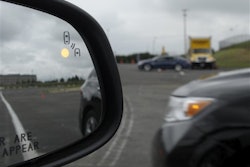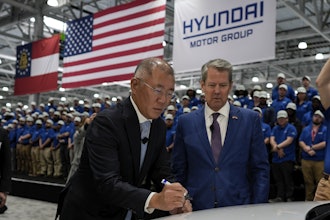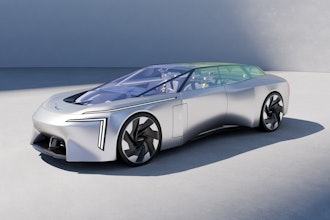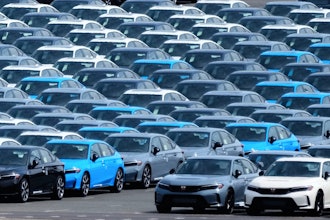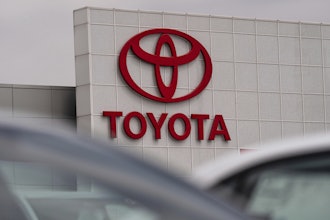MEDFORD, Ore. (AP) — The drive to become the world's top electric motorcycle maker has led Craig Bramscher around the globe — up twisting roads, off-road and face-to-face with corporate heads who share belief in the future of Brammo Motorsports' Enertia and Empulse.
It's also made those closest to him question his sanity at times.
In the days after Bramscher decided to develop and build electric motorcycles in Southern Oregon, he shared his vision with his wife. Jennifer Bramscher nodded and smiled reassuringly. Much later and millions of dollars down the road, she admitted what she really thought of the venture.
"She recently told some friends that she thought it was insane," Bramscher said.
At that point, Brammo had the American license to manufacture the Ariel Atom, a light-weight, high-speed, gas-powered automobile, and electric automaker Tesla had yet to debut its pricey products.
"Here we were with one of the fastest cars in the world and we were going to develop a relatively low-speed, battery-powered vehicle," he said. "Like everyone else, she thought motorcycles were supposed to make noise. She didn't tell me what she thought and let me pursue it.
"Once we got going she told me, 'You actually have a pretty good vision of the future.' I went from heel to hero."
Enertia models are now in production in Hungary, while the Empulse is going through final tweaks before assembly begins in July and production ramps up in August.
That should boost the company's Ashland employee count from 55 to 75 by year's end.
The journey has been anything but a straight shot, veering all over the globe as innovations and changing market conditions scrapped incumbent plans.
"We like disruptive ideas," Bramscher said. "They may not all work exactly the way we planned, but we learn so much each time."
There's an inside joke at Brammo's Clover Lane headquarters born of the company's pragmatic flexibility.
"Whenever we make a strong statement of what we are not going to do, everyone assumes we're going to get there very soon," Bramscher said. "You tell engineers something is not possible, they come back in a couple weeks and say here it is."
Batteries weren't on Bramscher's radar. After all, there were plenty of major players in the field.
"We said we would never build our own batteries. It was too research-intensive and too competitive," Bramscher said. "Clearly, there were billions of dollars invested in battery technology, why would we do that?"
It soon became apparent those billions of research dollars were targeted for automobiles. Promises of batteries with a higher energy density and lower costs failed to materialize. It turned out the battery packs Brammo developed for testing bikes in races on both sides of the Atlantic were a step or two ahead of what anyone else was making.
"We had developed the batteries specifically for racing — never with the intent of bringing them into production," he said. "But once we started, we saw that was what differentiates us from other bikes."
Likewise, Brammo didn't plan on engineering a gearbox into its bikes.
"Everyone talked about how we didn't need a gear box because electric motors had more torque and RPMs available," Bramscher said. "We believed it, too, and in many cases it's probably true."
But widespread efforts had proven a multiple-speed gear box provides early acceleration and high-speed performance. Brammo's Empulse has a 6-speed gear box.
"Doing the math, we found it would improve motorcyclists' control over the bike and give more regenerative braking (charging the battery while applying the brakes)."
After 2 1/2 years of development, Brammo has just brought the gear box into production, Bramscher said.
"At first, not everyone on our team liked it until we realized we had a good thing here," he said.
Outside investment has come from equity funds and two major corporations — Best Buy and recreational vehicle maker Polaris. The first round of funding opened eyes to electric motorcycles and the second has given it technical and operational advantages."
Four years ago, Brammo made headlines when it signed a deal with Best Buy and other players, infusing the company with $10 million in cash and giving the electronics firm exclusive rights to sell Brammo bikes at its stores. That model didn't last, but it scored marketing points for a tiny company in a small town and spread its brand beyond the biking world.
"Best Buy was a way-outside-the-box idea for bringing our early products to the competitive market," Bramscher said. "It was a stretch for them and a stretch for us. We got a lot of exposure and were able to capture 1 percent of the market share in stores where it was sold."
Best Buy remains an investor, but the retail giant has struggled and lost money in recent quarters.
"They are retrenching and very focused on their own business right now," Bramscher said.
At the time, Best Buy provided something Brammo didn't have — retail locations. Finding dealers to market electric motorcycles was an arduous prospect only a few years ago. But the ability to market a bike that can hit 100 mph with a range of 100 miles has changed all that.
"We weren't going to go with traditional motorcycle dealers," Bramscher said. "Now that the product is developed so much, that's our primary focus."
All the modifications and breakthroughs made Brammo bikes more appealing to a broader clientele and dealers.
"We wouldn't have been successful trying to do this three years ago with the first Enertia," Bramscher said. "The improvement of our technology, development of the battery, drive train and fast-charging capabilities — with all those things — suddenly it's a great bike that happens to be electric instead of a great bike with compromises. It's completely different now and appropriate for those dealers."
As of last week, 15 dealers were lined up, with "dozens in the queue across the country and some in Europe and Asia," he said. "We're expanding globally all at once."
In October, Minnesota-based Polaris Industries acquired a $28 million minority stake in Brammo. Again, it raised awareness of what Brammo is doing and underscored its advanced battery and drive-train technology.
Bramscher had long sought a relationship with the power-sports firm best known for its off-road vehicles and snowmobiles. But it wasn't until motorcycle enthusiast Scott Wine took over the top spot that obstacles melted away.
"It's a strategic partnership," Bramscher said. "We're interested in the way they run their company, the quality of their products, and their management is exceptional."
"We're not really out there on the Net to attract people," Bramscher said. "There are no prima donnas or rock stars. We're just a bunch of people who know how to hit doubles all day long."
Brammo's future in Southern Oregon remains a multimillion dollar question.
Bramscher said he moved here to raise his four children and has little desire to go elsewhere. Still, seven states are actively pursuing Brammo, hoping to convince him they are more supportive of his efforts than the government entities he presently deals with. One state has put together an incentive package worth $41 million. So far, he's taken the pitches without taking the bat off his shoulder.
"When there are opportunities for tens of millions of dollars, it's hard to ignore," he conceded. "As the CEO and a shareholder, I have to ponder the short and long term. There is a lot of interest in clean technology and transportation — not only in other states, but other countries. If there is any way possible to build the company and have the primary facility here and create jobs, that's what I want to do."
Bramscher said a 100,000-square-foot manufacturing site is necessary, and he hopes to eventually to be included in an enterprise zone, making expansion more feasible.
The long-term answer doesn't necessarily rely on state or local funding, but the willingness to reduce barriers to expansion.
Ashland has positioned itself as a place where companies can design and market products manufactured elsewhere, as is the case with Cropper Medical, the maker of Bio Skin, or develop software products such as Plexis Health Care.
"Our speciality is headquarters, design and research," said Ashland Mayor John Stromberg. "Companies value their most creative people and they are the ones that typically earn enough to be able to afford to live in Ashland."
While Ashland has yet to request inclusion in the Jackson County enterprise zone, the Ashland Planning Commission approved two 25,000-square-foot buildings for the company this spring.
"Brammo is an example of an innovative, creative, entrepreneurial-type of company that has been the focus of our diversified economy," Stromberg said. "Part of our strategy is to find all the ways we can be supportive of companies, not only establishing the business, but going through growth. We're interested in the expansion and we'll see if we can make it work, if they want to be in Ashland with a manufacturing plant."
Marc Zolton, a spokesman for Business Oregon, said the state has aided Brammo's development with about $1 million in grants and loans.
"We feel like we've been a partner with Brammo and in lockstep with them from the beginning," Zolton said. "It's the kind of company we like to see in Oregon, on the cutting edge, and we like how they are developing. But there are budgeting limits of what we can do here and what the state can do."
While acknowledging that the state and Southern Oregon Regional Economic Development Inc. have provided assistance, Bramscher needs to look only 500 miles to the south to see the backing his primary competitor is getting from its state government.
Earlier this month, the California Energy Commission awarded Santa Cruz-based Zero Motorcycle more than $1.8 million through its Alternative and Renewable Fuel and Vehicle Technology Program to expand its manufacturing capability in the Golden State.
"Even a couple million dollars can have big impact in a company's ability to conduct research and stay ahead," Bramscher said. "California is very aggressive about electric vehicles. It's also got a bigger population base to draw funds from."
Brammo's state income tax has "increased pretty dramatically" since setting up shop, he said. "When you just look at the spread sheet, we probably wouldn't be here if we just went by the numbers."
SOREDI Executive Director Ron Fox said he has met with Ashland City Council members and the mayor about inclusion in the Jackson County enterprise zone, which exempts capital expansion projects from property taxes for three years.
"I think there is more interest in Ashland about coming into the Jackson County enterprise zone now than at any time since I came here in 2006," Fox said. "Having a place for product development and with an enterprise zone, Ashland can be very competitive in this sort of competition."
Beyond the Ashland city limits there are other possibilities for potential expansion. Fox, among others, suggests the Talent Walmart building — scheduled for closing in the near future — is a plausible solution.
"We want to keep the research and development aspects of the business in the region," Fox said. "But as the company has evolved into an international producer of battery-powered motorcycles and scooters, I wouldn't be surprised to see a significant amount of manufacturing outside the state and U.S."
Brammo inked a deal with Singapore manufacturer Flextronics in September 2010, giving it an Asian beachhead. Last summer, production of Enertia and Enertia Plus models began at the Flextronics plant in Sàrvàr, Hungary.
Ultimately, what Brammo will look like in two or three years will depend on the company's ability to meet demand to match its marketing prowess.
"Some days I wake up and say this is really fun, but I would sure like to go two days without a surprise," Bramscher said. "The roller-coaster ride, where your stomach ends up in your throat every day, is getting a little easier, but every so often we run into a real doozy."
___
Information from: Mail Tribune, http://www.mailtribune.com/




